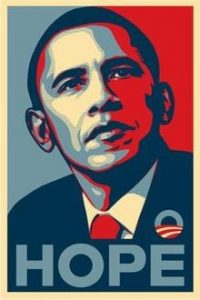
I had a pretty good idea what recently-watched movie I was going to attempt to “emoji-ize” while I was reading the articles this week… and then I came upon this quote:
“Representation and communication are motivated by the social; its effects are outcomes of the economic and the political. To think or act otherwise is to follow phantoms.” Kress (2005), p. 6
This immediately brought to mind this piece of graphic design:

This is an iconic poster; political in its inception, it has also influenced the artist economically as they and their form of art became more famous (or is it infamous?) after the release of this and broke into modern culture. I also found it completely ironic that this graphic designer’s chosen form of art actually make them and their fellow artists a form of a phantom (I might be giving too much away here).
“Graphic designers sought to show that a combination of word and image offered an experience that was more authentic than the conventional printed page could offer alone.” Bolter, J. D. (2001), p. 70
We all know there were numerous articles written in support of Barak Obama in his bid to become the 44th President of The United States. But this perfect blend of word and imagery, with the boldness of the picture combined with the colour palette (red, beige, and blue) and the single word “HOPE”, had more impact within the American culture than most written news stories did in 2008. It came to represent the 2008 Presidential race and is a perfect example of the “Breakout of the Visual”. Bolter, J. D. (2001)
I have digressed (sort of) from my emoji movie. This is a little bit more of an obscure movie but, after the epiphany I had above, I knew this film was the right one for this module and I wanted to attempt it. I started with the title; with this film I couldn’t think of where else to start. I relied on a combination of breaking words into syllables, swapping an emoji for an entire word, ignoring an article, and hoping (praying really) that some would get a few pop culture references. As per usual, I had professional help from my son; and his aid really showed me the differences between our generations. Even at eleven years old, and a very basic chat app on his Ipod, he was quick with coming up with what emoji could entirely replace a word, yet when I switched to syllables, actually breaking down the written language, it was I that came up with the emojis. I really felt like this title chose me after I had read both articles and I wholeheartedly recommend it… once you figure it out!
Another aside: I drove to Mt. Seymour this morning for my weekend bike ride. As I turned off the highway onto Mt. Seymour Parkway, I came upon road construction and a sign showing the speed and how much over the posted speed limit (40 km/hr) you are going. The sign started blinking 43 km/hr; I ignored it as 3 kms… come on! The sign then switched to a sad face emoji. I immediately started to slow down and feel guilty. I then thought, “Why? Why does that face have that effect on me, and obviously other people?” I just thought that this was such a bold example of how emojis are so powerful and absorbed within our new modern culture and that they are a language unto themslves.

2 Comments
Exit Through the Gift Shop
Though, I’m not sure if Shepard Fairey’s poster is what made him famous (I was wearing his brand Obey in high school!)
Yep, congrats! I love wearing my OBEY shirts at school! Had some weird looks from both my Principal and Superintendent though…